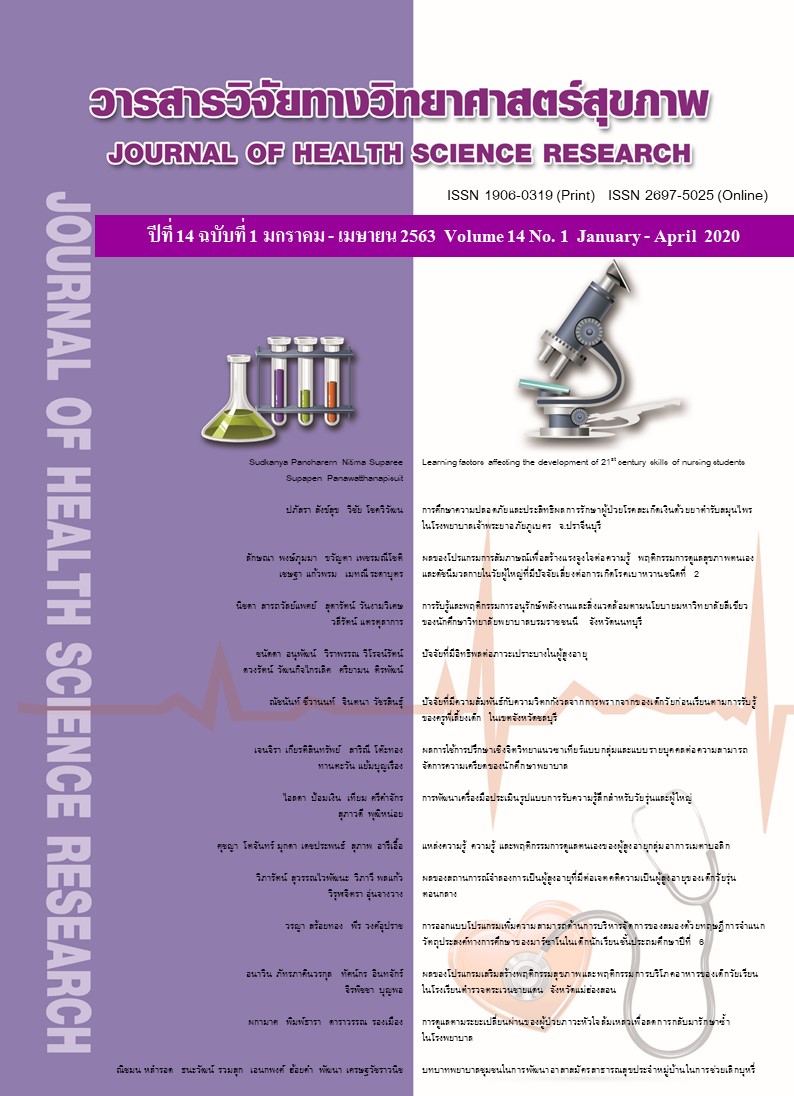การพัฒนาเครื่องมือประเมินรูปแบบการรับความรู้สึก สำหรับวัยรุ่นและผู้ใหญ่
Main Article Content
บทคัดย่อ
วัตถุประสงค์การวิจัย: เพื่อพัฒนาเครื่องมือประเมินรูปแบบการรับความรู้สึกสำหรับวัยรุ่นและผู้ใหญ่และตรวจสอบคุณภาพของเครื่องมือ
วิธีการวิจัย: พัฒนาเครื่องมือประเมินรูปแบบการรับความรู้สึกสำหรับวัยรุ่นและผู้ใหญ่ด้านความตรงเชิงเนื้อหาด้วยวิธีการหาค่าคะแนนดัชนีความสอดคล้องจากผู้เชี่ยวชาญ จำนวน 5 ท่าน และด้านความเที่ยงแบบค่าความสอดคล้องภายในด้วยวิธีหาค่าสัมประสิทธิ์แอลฟาครอนบาคในกลุ่มตัวอย่างอายุ 15 ปีขึ้นไป จำนวน 400 คน ในเขตพื้นที่อำเภอเมือง อำเภอดอยสะเก็ด และอำเภอแม่ออน จังหวัดเชียงใหม่ จากการสุ่มแบบหลายขั้นตอน และหาความเที่ยงแบบทดสอบซ้ำด้วยวิธีหาค่าสัมประสิทธิ์สหสัมพันธ์ภายในชั้นในกลุ่มตัวอย่างเดิม จำนวน 40 คน
ผลการวิจัย: เครื่องมือที่พัฒนาขึ้นประกอบด้วย 2 ชุดย่อย ได้แก่ ชุดที่ 1 รูปแบบความชอบทางการรับความรู้สึก จำนวน 50 ข้อ ลดลงจากเดิม 10 ข้อ และชุดที่ 2 รูปแบบความไวในการรับความรู้สึก จำนวน 60 ข้อเท่าเดิม แต่ละชุดจัดหมวดหมู่ข้อคำถามใหม่เป็น 6 ด้านคือ การมองเห็น การได้ยิน การดมกลิ่นและรับรส กายสัมผัส การทรงตัวและการรับความรู้สึกจากกล้ามเนื้อ เอ็น และข้อต่อ ใช้เวลาในการทดสอบลดลงเหลือ 5-10 นาที จากการทดสอบความตรงเชิงเนื้อหามีค่าคะแนนดัชนีความสอดคล้องของเครื่องมือชุดที่ 1 และ ชุดที่ 2 อยู่ระหว่าง 0.60-1.00 ความเที่ยงแบบค่าความสอดคล้องภายในมีค่าสัมประสิทธิ์แอลฟาครอนบาคของเครื่องมือชุดที่ 1 เท่ากับ .89 และชุดที่ 2 เท่ากับ .79 และความเที่ยงแบบทดสอบซ้ำมีค่าสัมประสิทธิ์สหสัมพันธ์ภายในชั้นของเครื่องมือชุดที่ 1 เท่ากับ .91 และ ชุดที่ 2 เท่ากับ .92
สรุปผล: เครื่องมือประเมินรูปแบบการรับความรู้สึกสำหรับวัยรุ่นและผู้ใหญ่ มีค่าความตรงและความเที่ยงอยู่ในเกณฑ์ที่ยอมรับได้
Downloads
Article Details
บทความที่ได้รับการตีพิมพ์เป็นลิขสิทธิ์ของวิทยาลัยพยาบาลบรมราชชนนี จังหวัดนนทบุรี
ข้อความที่ปรากฏในบทความแต่ละเรื่องในวารสารวิชาการเล่มนี้เป็นความคิดเห็นส่วนตัวของผู้เขียนแต่ละท่านไม่เกี่ยวข้องกับวิทยาลัยพยาบาลบรมราชชนนี จังหวัดนนทบุรี และคณาจารย์ท่านอื่น ในวิทยาลัยฯ แต่อย่างใด ความรับผิดชอบองค์ประกอบทั้งหมดของบทความแต่ละเรื่องเป็นของผู้เขียนแต่ละท่าน หากมีความผิดพลาดใด ๆ ผู้เขียนแต่ละท่านจะรับผิดชอบบทความของตนเองแต่ผู้เดียว
เอกสารอ้างอิง
Siegel A, Sapru HN. Essential neuroscience: Holistic approach. 3rded. China: Wolters Hluwer; 2015.
Kandel E, Schwartz J, Jessell T. Principles of neural science. 5thed. New York: McGrow-Hill; 2013.
Dunn W. The Role of Sensory Processing in the Everyday Lives of Older Adults. OTJR (Thorofare N J). 2003;23(3):99-106.
Dunn W. Living sensationally: Understanding your senses. London: Jessica Kingsley; 2008.
Chang FY, Huang H C, Lin K C, Lin L C. The effect of a music programme during lunchtime on the problem behavior of the older residents with dementia at an institution in Taiwan. J Clin Nurs. 2010; 19(7-8):939-48.
Wu MC, Sung HC, Lee WL, Smith GD. The effects of light therapy on depression and sleep disruption in older adults in a long-term care facility. Int J Nurs Pract. 2015;21(5):653-9.
Karadag E, Samancioglu S, Ozden D, Bakir E. Effects of aromatherapy on sleep quality and anxiety of patients. Nurs Crit Care. 2015;22(2):105-12.
Fava L, Strauss K. Multi-sensory room: Comparing effects of the Snozelen and the stimulus preference environment on the behavior of adults with profound mental retardation. Res Dev Disabil. 2010;31(1):160-71.
Chalmers A, Harrison S, Mollison K,
Molloy N, Gray K. Establishing sensory-based approaches in mental health inpatient care: A multidisciplinary approach. Australas Psychiatry. 2012;20(1):35-9.
Maseda A, Cibeira N, Lorenzo-López L, González-Abraldes I, Buján A, Labra C, et al. Multisensory Stimulation and Individualized Music Sessions on Older Adults with Severe Dementia: Effects on Mood, Behavior and Biomedical Parameters. J Alzheimers Dis. 2018;63(4):1415-25.
Brown C, Tollefson N, Dunn W, Cromwell R, Filion D. The Adult Sensory Profile: Measuring Patterns of Sensory Processing. Am J of Occup Ther. 2001;55(1):75-82.
Dunn W. Sensory profile: User’s manual. San Antonio, TX: Psychological Corporation; 1999.
Dunn W. Infant toddler sensory profile: User’s manual. San Antonio, TX: Psychological Corporation; 2002.
Dunn W. Sensory profile school companion: User’s manual. San Antonio, TX: Pearson; 2006.
Glennon T, Miller-Kuhaneck H, Henry DA, Parham LD, Ecker C. Sensory processing measure manual. Los Angeles, CA: Western Psychological Services; 2007.
Brown C, Dunn W. The adolescent/adult sensory profile: User’s manual. San Antonio, TX: Psychological Corporation; 2002.
Collier L. The sensory assessment and profiling tool. UK: Rompa;2003.
Srikhamjak T, Sawlom S, Munkhetvit P, Apikimonkon H. Thai Sensory Profile Assessment Tool. Chiang Mai University; 2550. (in Thai).
Jittrong P. Sensory and Leisure Interest Profile in Late Teenagers, Mueang District, Chiang Mai Province [Dissertation]. Chiang Mai: Chiang Mai University; 2012. (in Thai).
Kongngern T, Srikhamjak T. Relationship between sensory patterns and stresses of relapsed alcohol dependence clients in Suansaranroom Psychiatric Hospital, Suratthani Province. The journal of Occupational Therapist Association of Thailand. 2011;16(1):26-44. (in Thai).
Kispredarborisuthi B. Formulating research instrument. 7thed. Bangkok: Srianant; 2010. (in Thai).
Ellis P D. The Essential Guide to Effect Sizes: Statistical Power, Meta-Analysis, and the Interpretation of Research Results [Internet]. 2010 [cited 2019 May 9]; Available from: https://epdf.pub/the-essential-guide-to-effect-sizes-statistical-power-meta-analysis-and-the-inte.html.
Vanichbuncha K. Statistic for Research. 11sted. Bangkok: Samlada; 2017. (in Thai).
Portney LG, Watkins MP. Foundation clinical research: Applications to practice. 3rded. Upper Saddle River: Pearson Education, Inc; 2009.
Cicchetti DV,Sparrow SA. Developing criteria for establishing interrater reliability of specific items: Applications to assessment of adaptive behavior. Am J Ment Defic. 1981;86(2):127-37.


